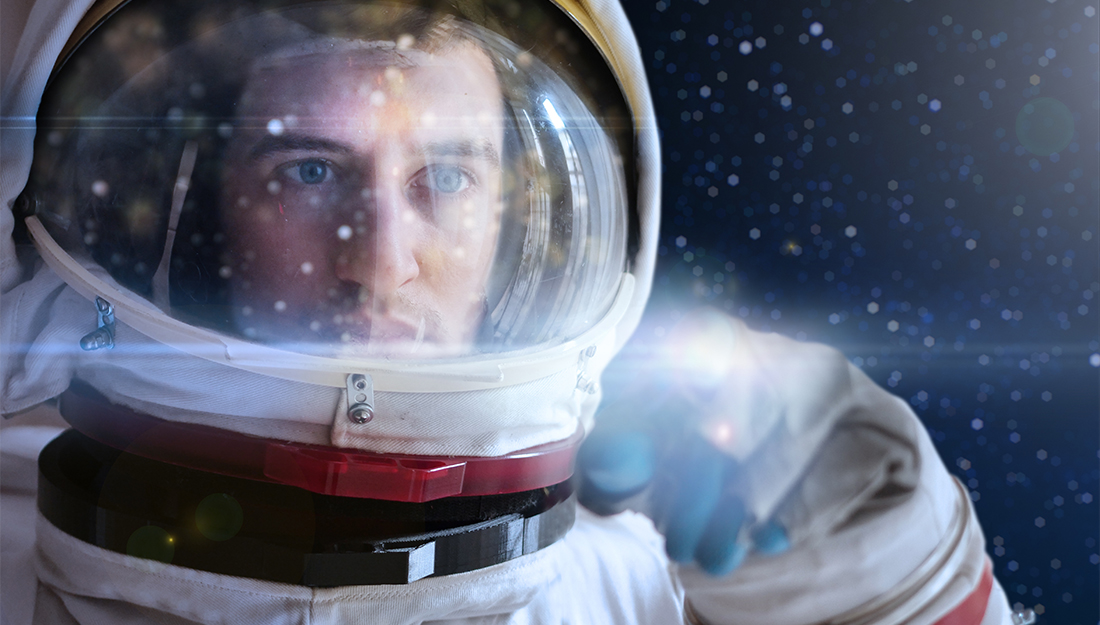- Gracie Blackwell
- Featured, Medicine, Research, Show on VR homepage
How does long-term spaceflight affect vision?
College of Medicine researchers team up with NASA to help find solutions for astronauts that develop spaceflight-related eye conditions

When astronauts spend at least a month in space, a significant fraction of them (about 60 percent) experience negative changes to their bodies due to the effect of microgravity and possibly other things like increased radiation exposure. One of these changes is Spaceflight-Associated Neuro-Ocular Syndrome (SANS), a condition in the eye that can lead to decreased sharpness of vision and changes such as swelling and flattening of structures in the eye.
As NASA is gearing up for a return to the moon and eventually a mission to Mars (which would require humans to spend 1.5 to 2.5 years in space), solving this issue has become increasingly important. NASA has chosen researchers from the Texas A&M University College of Medicine to conduct an investigation on the effect of long-term spaceflight on the eyes and on the arteries, veins and lymphatic vessels that serve the eye and maintain vision.
“NASA is worried about the impact that long-term spaceflight will have on astronauts’ health and their ability to complete missions, because of the fact that their vision can be significantly impaired,” said David C. Zawieja, PhD, Regents Professor at the Texas A&M College of Medicine and lead investigator of the experiment. “Their vision can be impaired—it can be temporary, it can be permanent, it can be mild, it can be severe, it can be in one eye more than the other. There’s a lot that we don’t know, but what we do know is that this is a mission-critical problem.”
The project, also known as the Rodent Research 23 (RR-23) mission, launched a total of 20 animal models this past December to the International Space Station (ISS) for a duration of about five weeks. This week, the animal models returned to Earth, were delivered to NASA’s Kennedy Space Center in Florida and then flown directly to College Station, where the experiments are currently being conducted by specialized teams from the College of Medicine and colleagues.
This is the first time in history that experiments on live animals are brought back from space to a non-NASA affiliated institution or group, an arrangement that was partly due to the COVID-19 pandemic’s social distancing measures necessitating more lab space.
Co-investigator teams on this project include those from the labs of Pooneh Bagher, PhD, assistant professor, Anatoliy Gashev, MD, PhD, DMSC, associate professor, Travis Hein, PhD, professor, all in the Department of Medical Physiology at the Texas A&M College of Medicine, and Binu Tharakan, PhD, associate professor and director of research in the Department of Surgery at the Morehouse School of Medicine. In addition, Farida Sohrabji, PhD, interim department chair, professor, and David Earnest, PhD, professor, both in the Department of Neuroscience and Experimental Therapeutics at the Texas A&M College of Medicine, are also helping with their respective teams.
In 2017, Zawieja and his colleagues worked on a similar project, called the Rodent Research 9 (RR-9) mission, that also studied the effects of long-term microgravity on eyesight. They studied the vascular dynamics in the brain and spinal cord and examined the potential impact of changes in cerebral spinal fluid pressure on animal models they launched to the ISS.
For this RR-23 mission, Zawieja and his colleagues are taking a different approach. Instead of studying the micro vessels of the brain, this research focuses on the potential imbalance of the microcirculation in the eye itself, creating local edema particularly near the back of the eye.
“Since astronauts have been spending more than a few hours or even a day or two in space, there is a very well-defined redistribution of body fluids,” Zawieja said. “What happens is they kind of get chicken legs and buffalo torsos and a puffy head and neck because the fluids that will normally drain toward your feet and your legs on Earth now don’t have gravity pulling them down. A lot of fluids will get redistributed centrally and toward the head and neck which produces a number of issues for the astronauts—stuffy nose, puffy face, puffy neck and potentially SANS.”
Currently, the teams are dissecting and examining the various structures of and in the eye in the animal models. The teams are currently analyzing the models to see if the vessels are working normally. If they find that the vessels are working abnormally, they will further examine the models to see if there is evidence of potential localized edema in the back of the eye that could be compressing the optic nerve and producing the pathology associated with SANS—loss of visual acuity. They will also compare the space animal model results to two other control groups that stayed on Earth.
The teams must dissect and examine the flight animal model within a very short time frame before the effects of weightlessness start reversing.
“The idea is to try to catch whatever changes may have occurred before they start reversing,” Zawieja said. “The good thing is we know from other data that it takes probably a minimum of three to five days before these effects start reversing and going back to normal because the vessels will eventually adapt to the local environment that they’re in.”
The research conducted from RR-23 will allow scientists to better understand the impacts of long-term spaceflight on SANS and in the future, create countermeasures that will prevent astronauts from developing SANS. “We suspect that the final analyses from this project will also help determine the future success of longer space missions to destinations like Mars,” Zawieja said.
Zawieja anticipates that the final analyses and examinations of the RR-23 mission will conclude at the beginning of 2022.
Media contact: media@tamu.edu


